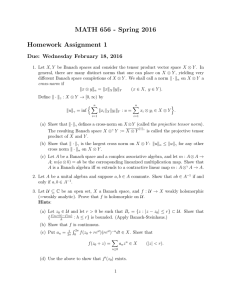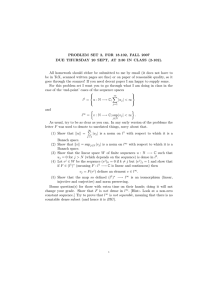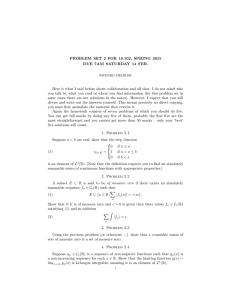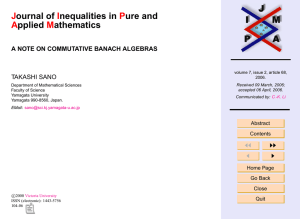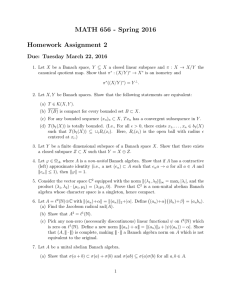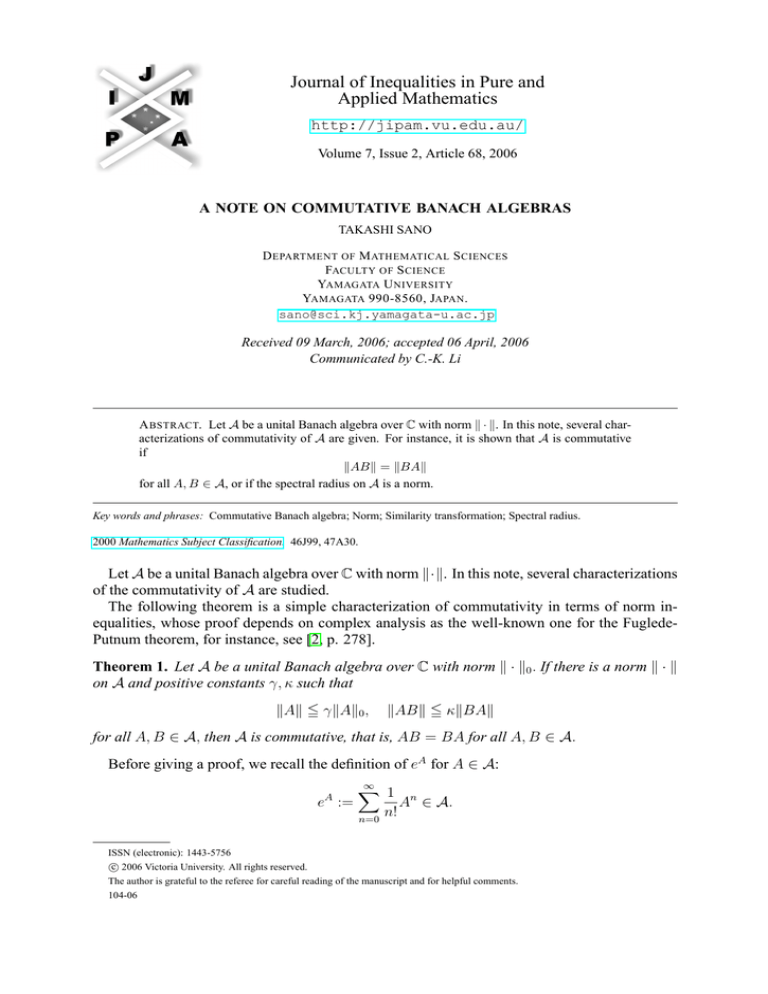
Journal of Inequalities in Pure and
Applied Mathematics
http://jipam.vu.edu.au/
Volume 7, Issue 2, Article 68, 2006
A NOTE ON COMMUTATIVE BANACH ALGEBRAS
TAKASHI SANO
D EPARTMENT OF M ATHEMATICAL S CIENCES
FACULTY OF S CIENCE
YAMAGATA U NIVERSITY
YAMAGATA 990-8560, JAPAN .
sano@sci.kj.yamagata-u.ac.jp
Received 09 March, 2006; accepted 06 April, 2006
Communicated by C.-K. Li
A BSTRACT. Let A be a unital Banach algebra over C with norm k · k. In this note, several characterizations of commutativity of A are given. For instance, it is shown that A is commutative
if
kABk = kBAk
for all A, B ∈ A, or if the spectral radius on A is a norm.
Key words and phrases: Commutative Banach algebra; Norm; Similarity transformation; Spectral radius.
2000 Mathematics Subject Classification. 46J99, 47A30.
Let A be a unital Banach algebra over C with norm k·k. In this note, several characterizations
of the commutativity of A are studied.
The following theorem is a simple characterization of commutativity in terms of norm inequalities, whose proof depends on complex analysis as the well-known one for the FugledePutnum theorem, for instance, see [2, p. 278].
Theorem 1. Let A be a unital Banach algebra over C with norm k · k0 . If there is a norm k · k
on A and positive constants γ, κ such that
kAk 5 γkAk0 ,
kABk 5 κkBAk
for all A, B ∈ A, then A is commutative, that is, AB = BA for all A, B ∈ A.
Before giving a proof, we recall the definition of eA for A ∈ A:
eA :=
∞
X
1 n
A ∈ A.
n!
n=0
ISSN (electronic): 1443-5756
c 2006 Victoria University. All rights reserved.
The author is grateful to the referee for careful reading of the manuscript and for helpful comments.
104-06
2
T. S ANO
The assumption that A is a complete, unital normed algebra with a submultiplicative norm
guarantees the convergence of this infinite series in A and implies
d zA
e = AezA (z ∈ C).
dz
Proof. Let A, B ∈ A. Let us consider the normed space (A, k · k). For each bounded linear
functional ϕ on this normed space, we define a complex-valued function f on C by
f (z) := ϕ(ezA Be−zA )
(z ∈ C).
Then the first assumption of k · k guarantees that f is an entire analytic function. f is also
bounded: in fact, by the second assumption
|f (z)| 5 kϕkkezA Be−zA k
5 κkϕkkBe−zA · ezA k
= κkϕkkBk < ∞
(z ∈ C).
Thus, by the Liouville theorem, f is constant. Hence,
0 = f 0 (z) = ϕ (AezA )Be−zA + ezA B(−Ae−zA ) .
Putting z = 0 yields
ϕ(AB − BA) = 0
for each bounded linear functional ϕ on A. By the Hahn-Banach theorem, AB = BA and the
proof is completed.
Remark 2.
(1) By considering completion, we find it sufficient to assume in Theorem 1 that A is a
unital normed algebra over C with submultiplicative norm k · k0 .
(2) The assumption that
kABk 5 κkBAk
for all A, B ∈ A can be replaced with a weaker one
kSAS −1 k 5 κkAk
for all A ∈ A and all invertible S ∈ A, or even further
kezA Be−zA k 5 κkBk
for all A, B ∈ A and all z ∈ C. In fact, it is essential to the proof of Theorem 1 that for
given A, B
sup{kezA Be−zA k : z ∈ C} < ∞.
Theorem 1 and Remark 1 (2) yield:
Corollary 3. Let A be a unital Banach algebra over C with norm k · k. Suppose that there is a
positive constant γ such that
kABk 5 γ kBAk
for all A, B ∈ A. Then A is commutative. In particular, if kABk = kBAk for all A, B ∈ A,
then A is commutative.
Corollary 4 ([1, Exercise IV 4.1]). On the set of all complex n-square matrices for n = 2 no
norm is invariant under all similarity transformations.
See [1, p.102] for similarity transformations.
J. Inequal. Pure and Appl. Math., 7(2) Art. 68, 2006
http://jipam.vu.edu.au/
A N OTE ON C OMMUTATIVE BANACH A LGEBRAS
3
Corollary 5. Let A be a unital Banach algebra over C with norm k · k. If the spectral radius is
a norm on A, then A is commutative.
This follows from Theorem 1 and the properties of the spectral radius r(A) that r(AB) =
r(BA) and r(A) 5 kAk for A, B ∈ A.
Remark 6. There is a unital Banach algebra whose spectral radius is not a norm but a seminorm. This semi-norm condition is not sufficient for commutativity.
In fact, let A (j Mn (C)) be the set of upper triangular matrices whose diagonal entries
are identical; A consists of A := (aij ) ∈ Mn (C) such that a11 = a22 = · · · = ann (=: α)
and aij = 0 (i > j). For this A, r(A) = |α| and the spectral radius on A is a semi-norm.
Therefore, the unital Banach algebra A is a non-commutative example.
R EFERENCES
[1] R. BHATIA, Matrix Analysis, Springer-Verlag (1996).
[2] J.B. CONWAY, A Course in Functional Analysis, 2nd Ed., Springer-Verlag, (1990).
J. Inequal. Pure and Appl. Math., 7(2) Art. 68, 2006
http://jipam.vu.edu.au/

